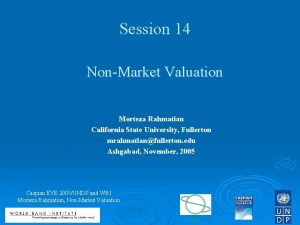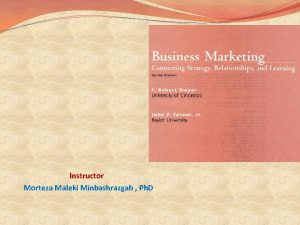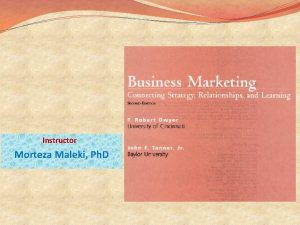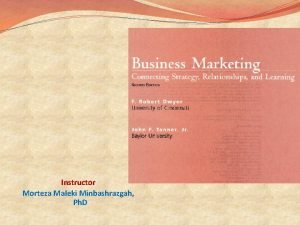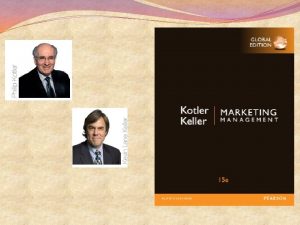Instructor Morteza Maleki Ph D Components of a


































- Slides: 34

Instructor Morteza Maleki, Ph. D


Components of a Modern Marketing Information Systems �The major responsibility for identifying significant marketplace changes falls to the company’s marketers; � They have disciplined methods for collecting info, � They spend more time than anyone else interacting with customers & observing competition & other outside firms & groups. 3

Components of a Modern Marketing Information Systems 4

Components of a Modern Marketing Information Systems �Some managers complain about 1. 2. 3. Not knowing how to get hold of critical information, Getting too much information that they can not use & too little that they really need, & Getting important info too late. 5

Components of a Modern Marketing Information Systems �Companies with superior info enjoy a competitive advantage. 1. 2. 3. They can choose their markets better, They can develop better offerings, & They can execute better marketing planning. 6

Components of a Modern Marketing Information Systems Marketing Information System (MIS) � Every firm must organize & distribute a continuous flow of info to its marketing managers. �MIS consists of people, equipment, & procedures to gather, sort, analyze, evaluate, & distribute needed, timely, & accurate info to marketing decision makers. � It relies on internal company’s records, marketing intelligence activities, & marketing research. �The company’s MIS should be a cross between � � � What managers think they need, What they really need, & What is economically feasible. 7

Components of a Modern Marketing Information Systems 8

Internal Records Marketing managers rely on internal reports of orders, sales, prices, costs, inventory levels, receivables, payables, & so on, by which they can spot important opportunities & problems. 9

Internal Records Order-to-Payment Cycle �The heart of the internal record system is the order-to- payment cycle. � � � Sales representatives, dealers, & customers send orders to firm. The sales department prepares invoices, transmit copies to various departments, & back-orders out-of-stock items. Shipped items generate shipping & billing documents that go to various departments. �Companies need to perform these steps quickly & accurately, because customers favor firms that can promise timely delivery. � Companies are using the Internet & extranets to improve the speed, accuracy, & efficiency of the order-to-payment cycle. 10

Internal Records Sales Information Systems � Marketing managers need timely & accurate reports on current sales. � Wal-Mart, for instance, operates a sales & inventory data warehouse that captures data on every item, for every customer, for every store, every day, and refreshes it every hour. � Technological gadgets are revolutionizing sales info systems & allowing representatives to have up-to-second information. 11

Internal Records Sales Information Systems � Companies must carefully interpret the sales data so as not to draw the wrong conclusions; Michael Dell gave this illustration: “If you have three yellow mustangs sitting on a dealer’s lot & a customer wants a red one, the salesman maybe really good at figuring out how to sell the yellow mustang. So the yellow mustang gets sold, & the signal gets sent back to the factory that, hey, people want yellow mustang. ” � 12

Internal Records Database, Data Warehousing, & Data Mining � Today, companies organize their info into databases—customer databases, product databases, salesperson databases--& then combine data from the different databases. �A company can rank its customers according to purchase recency, frequency, & monetary value (RFM) & send the new offers to only the highest scoring customers. � Besides saving on mailing expenses, this manipulation of data can often achieve a double-digit response rate. 13

Internal Records Database, Data Warehousing, & Data Mining (con. . ) �By hiring analysts skilled in sophisticated statistical methods, companies can “mine” the data & garner fresh insights into neglected customer segments, recent customer trends, & other useful information. 14

Marketing Intelligence �The internal records system supplies results data, but the marketing intelligence system supplies happenings data. �The Marketing Intelligence Systems (MIS) is a set of procedures & sources managers use to obtain everyday info about developments in the marketing environment. 15

Marketing Intelligence �Marketing managers collect marketing intelligence by 1. 2. 3. 4. 5. Reading books, newspapers, & trade publications, Talking to customers, suppliers, and distributors, Monitoring “social media” on the Internet via online discussion groups, E-mailing lists & blogs, & Meeting with other company managers. 16

Marketing Intelligence A company can take several steps to improve the quality of its marketing intelligence; 1. 2. 3. 4. 5. 6. 7. Train & motivate the sales force to spot & report new developments, Motivate distributors, retailers, & other intermediaries to pass along important intelligence, Network externally, Set up a customer advisory panel, Take advantage of government data resources, Purchase info from outside suppliers Use online customer feedback systems to collect competitive intelligence 17

Analyzing the Macro-Environment NEEDS & TRENDS � Enterprising individuals & companies manage to create solutions to unmet customer needs. �There is difference between fads, trends, & megatrends; � A FAD is unpredictable, short-lived & without social, economic, & political significance; � The company can cash on them, yet getting it right is more a matter of luck & good timing than anything else. 18

Analyzing the Macro-Environment �A TREND is a direction or sequence of events that has some momentum & durability. � Trends are more predictable & durable than fads; a trend reveals the shape of future & provides many opportunities. �A MEGATREND has been described as large social, economic, political, & technological changes that are slow to form, & once in place, they influence us for some time—between seven to ten years, or longer. 19

Analyzing the Macro-Environment IDENTIFYING THE MAJOR FORCES �Macro-environmental forces & trends are “noncontrollable”, which the company must monitor & to which it must respond. �A series of challenges firms face are; 1. 2. 3. 4. The steep decline of the stock market, which affected savings, investment, & retirement funds, Increasing unemployment, Corporate scandals, & The rise of terrorism 20

Analyzing the Macro-Environment �Hence, the firms must monitor six major forces; 1. 2. 3. 4. 5. 6. Demographic Environment, Economic Environment, Social-cultural Environment, Natural Environment, Technological Environment, & Political-legal Environment 21

Analyzing the Macro-Environment 1. The Demographic Environment �The main demographic force that marketers monitor is population, because people make up markets. �Marketers are keenly into 1. 2. 3. 4. 5. The size & growth rate of population in cities, regions, & nations, Age distribution & ethnic mix, Educational levels, Household patterns, & Regional characteristics & movements 22

Analyzing the Macro-Environment 2. ECONOMIC ENVIRONMENT �The available purchasing power in an economy depends on current income, prices, savings, debt, & credit availability. �Marketers must pay careful attention to trends affecting purchasing power, because they can have strong impact on business, especially for companies whose products are geared to high-income & price-sensitive consumers. 23

Analyzing the Macro-Environment Income Distribution �The marketers need to understand the distribution of income to reach more meaningful conclusions about taking specific decisions. �Changes in economic well-being of the population creates opportunities for companies in terms of higher demand for existing products & services as well as for new offers. �For several product categories, the demand is likely to increase as a result of growth in income & the number of households with greater purchasing powers. 24

Analyzing the Macro-Environment 3. SOCIAL-CULTURAL ENVIRONMENT Society shapes the beliefs, values, & norms that largely define consumer tastes & preferences. � People have a world view that, almost unconsciously, defines their relationships to themselves, to others, to organizations, to society, to nature & to the universe. Values, attitudes, & aspirations of people vary significantly across different customer groups & regions. � This implies the need to conduct customized research on consumption behavior & attitudes, specific to products & services that the marketer is interested in. � Each element of marketing decision needs to be fine-tuned to reflect the needs, aspirations, & attitudes of consumers who show distinctiveness in preferences & habits across consumer segments. 25

Analyzing the Macro-Environment 4. NATURAL ENVIRONMENT �The deterioration of the natural environment is a major global problem. �Consumers often appear conflicted about product decisions that affect the natural environment. � One research study showed that although 80% of U. S. consumers said environmental safety influenced their decision to buy a product, only a little over half asserted that they bought recycled or environmentally safe products. 26

Analyzing the Macro-Environment �Corporate environmentalism is the recognition of the importance of environmental issues facing the firm and the integration of those issues into the firm’s strategic plans. �Marketers practicing corporate environmentalism need to be aware of the threats & opportunities associated with four major trends in the natural environment; 1. 2. 3. 4. The shortage of raw materials, especially water, The increased cost of energy, Increased pollution levels, & The changing role of governments 27

Analyzing the Macro-Environment 5. TECHNOLOGICAL ENVIRONMENT �One of the most dramatic forces in people’s life � Every new technology is a force for “creative destruction”. �In the time between major innovations, an economy can stagnate. � In the meantime, the minor innovations fill the gap. � They require less risk, but they can also divert research effort away from major breakthroughs. 28

Analyzing the Macro-Environment �New technology create major long-term consequences that are not always foreseeable. � For instance, the contraceptive pills helped lead to smaller families, more working wives, & larger discretionary incomes—resulting in higher expenditures on vacation travel, durable goods, & luxury items. �Marketers should follow four trends in technology; 1. 2. 3. 4. Accelerating pace of change Unlimited opportunities for innovation Varying R&D budgets Increased regulation of technological change 29

Analyzing the Macro-Environment 6. POLITICAL-LEGAL ENVIRONMENT �The political & legal environment consists of laws, government agencies, & pressure groups that influence & limit various orgs and individuals. �Sometimes these laws create new opportunities for businesses; �Mandatory recycling laws have given the recycling industry a major boost & spurred the creation of dozens of new companies making new products from recycled materials. 30

Analyzing the Macro-Environment Increase in Business Legislation �Business legislation has four purposes; 1. 2. 3. 4. To protect companies from unfair competition, To protect consumers from unfair business practices. To protect the interest of society from unbridled business behavior, & To charge businesses with the social costs created by their products or production processes �Companies generally establish legal review procedures & promulgate ethical standards to guide their marketing managers; � As more businesses take place in cyberspace, marketers must establish new parameters for doing electronic business ethically. 31

Analyzing the Macro-Environment Growth of Special-interest Groups �An important force affecting business is the consumerist movement. �It is an organized movement by the citizens & the government to strengthen the rights & powers of buyers in relation to sellers. 32

Analyzing the Macro-Environment Consumer Protection Act, of India (1986) focuses on 6 rights of consumers; 1. SAFETY; the right to be protected against the marketing of goods & services that are hazardous to life & property. 2. INFORMATION; to protect consumers against unfair trade practices, & the right to be informed about quality, quantity, purity, standard, & price. 3. CHOICE; the right to choose a variety of products & services at competitive prices. 4. REPRESENTATION; the right to be heard & be assured that the consumer’s interests are received due considerations at appropriate forums. 1. 5. REDRESSAL; the right to seek redressal against unfair & restrictive trade practices, & unscrupulous exploitation of consumers. 6. CONSUMER EDUCATION; the right to consumer education. 33

The End
 Example of data gathering procedure
Example of data gathering procedure Morteza maleki
Morteza maleki Reza entezari maleki
Reza entezari maleki Morteza anvari
Morteza anvari Morteza farajian
Morteza farajian Morteza katouzian
Morteza katouzian Isaep model
Isaep model Cost analysis requirements description
Cost analysis requirements description Morteza farajian
Morteza farajian Morteza rahmatian
Morteza rahmatian Morteza farajian
Morteza farajian Delmar cengage learning instructor resources
Delmar cengage learning instructor resources Nfpa 1403 instructor to student ratio
Nfpa 1403 instructor to student ratio Tcole advanced instructor course
Tcole advanced instructor course Subject verb agreement exercise
Subject verb agreement exercise Njrotc instructor vacancies
Njrotc instructor vacancies Instructor
Instructor Acr medical term
Acr medical term Basic instructor course #1014
Basic instructor course #1014 Nra certified instructor logo
Nra certified instructor logo Basic instructor course texas
Basic instructor course texas Tp 12863
Tp 12863 Instructor vs teacher
Instructor vs teacher Tcole advanced instructor course
Tcole advanced instructor course Nrp instructor toolkit
Nrp instructor toolkit Ac 61-65
Ac 61-65 Basic instructor course #1014
Basic instructor course #1014 Basic instructor course texas
Basic instructor course texas Instructor office hours
Instructor office hours Naismith was an instructor of
Naismith was an instructor of Basic instructor course texas
Basic instructor course texas Instructor operating station
Instructor operating station Ospfv
Ospfv Jrotc marksmanship instructor course online
Jrotc marksmanship instructor course online Utp cable
Utp cable









